Middleton W.M. (ed.) Reference Data for Engineers: Radio, Electronics, Computer and Communications
Подождите немного. Документ загружается.

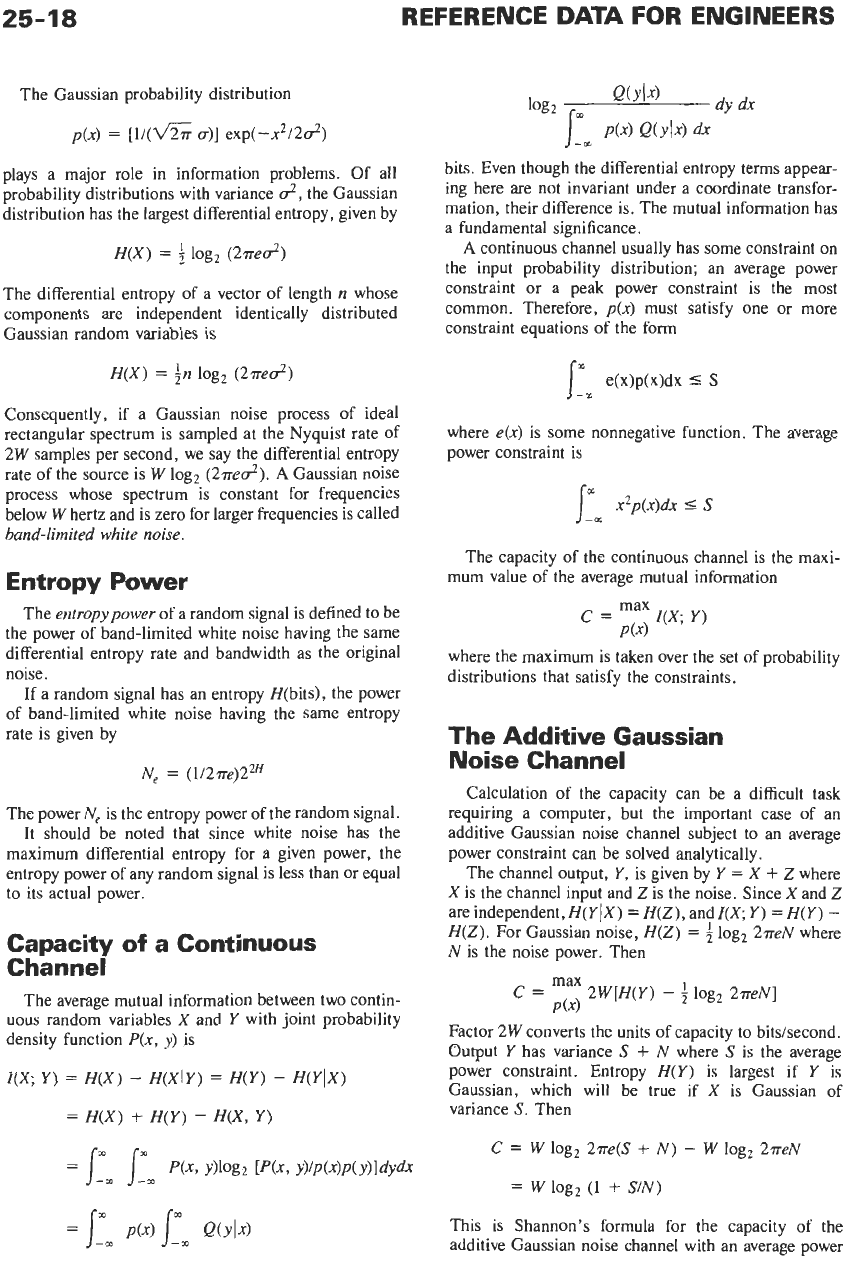
25-18
REFERENCE
DATA
FOR
ENGINEERS
The Gaussian probability distribution
p(x)
=
[I/(&
g)]
exp(-x2/2c?)
plays a major role in information problems. Of all
probability distributions with variance
c?
,
the Gaussian
distribution has the largest differential entropy, given by
H(X)
=
log,
(27re0-7
The differential entropy of a vector of length
n
whose
components are independent identically distributed
Gaussian random variables is
H(X)
=
in
log,
(2.rred)
Consequently, if a Gaussian noise process of ideal
rectangular spectrum is sampled at the Nyquist rate of
2W
samples per second, we say the differential entropy
rate of the source is
W
log2
(27red).
A
Gaussian noise
process whose spectrum is constant for frequencies
below
W
hertz and is zero for larger frequencies is called
band-limited white noise.
Entropy Power
The
entropy power
of a random signal is defined to be
the power of band-limited white noise having the same
differential entropy rate and bandwidth as the original
noise.
If
a random signal has an entropy H(bits), the power
of band-limited white noise having the same entropy
rate is given by
Ne
=
(1/2~e)2,~
The power
Ne
is the entropy power of the random signal.
It should be noted that since white noise has the
maximum differential entropy for a given power, the
entropy power of any random signal is less than or equal
to its actual power.
Capacity
of
a Continuous
Channel
The average mutual information between two contin-
uous random variables
X
and
Y
with joint probability
density function
P(x,
y)
is
Z(X
Y)
=
H(X)
-
H(XJY)
=
H(Y)
-
H(Y1X)
=
H(X)
+
H(Y)
-
H(X, Y)
bits. Even though the differential entropy terms appear-
ing here are not invariant under a coordinate transfor-
mation, their difference is. The mutual information has
a fundamental significance.
A
continuous channel usually has some constraint on
the input probability distribution; an average power
constraint or a peak power constraint is the most
common. Therefore,
p(x)
must satisfy one or more
constraint equations of the form
e(x)p(x)dx
5
S
I:.
where
e(x)
is some nonnegative function. The average
power constraint is
x2p(x)dx
5
S
J
-00
The capacity of the continuous channel is the maxi-
mum value of the average mutual information
max
c
=
I(X,
Y)
P(X)
where the maximum is taken over the set of probability
distributions that satisfy the constraints.
The Additive Gaussian
Noise Channel
Calculation of the capacity can be a difficult task
requiring a computer, but the important case of an
additive Gaussian noise channel subject
to
an average
power constraint can be solved analytically.
The channel output,
Y,
is given by
Y
=
X
+
Z
where
X
is the channel input and
Z
is the noise. Since
X
and
2
are independent,
H(YIX)
=
H(Z),
andZ(X
Y)
=
H(Y)
-
H(Z).
For Gaussian noise,
H(Z)
=
log,
27reN
where
N
is the noise power. Then
max
P(X)
C
=
2W[H(Y)
-
f
log,
2~reNI
Factor 2W converts the units of capacity to bits/second.
Output
Y
has variance
S
+
N
where
S
is
the average
power constraint. Entropy
H(Y)
is largest if
Y
is
Gaussian, which will be true if
X
is Gaussian of
variance
S.
Then
C
=
W
log,
2rre(S
-k
N)
-
W
log1
27reN
=
W
log,
(1
+
S/N)
This is Shannon’s formula for the capacity of the
additive Gaussian noise channel with an average power
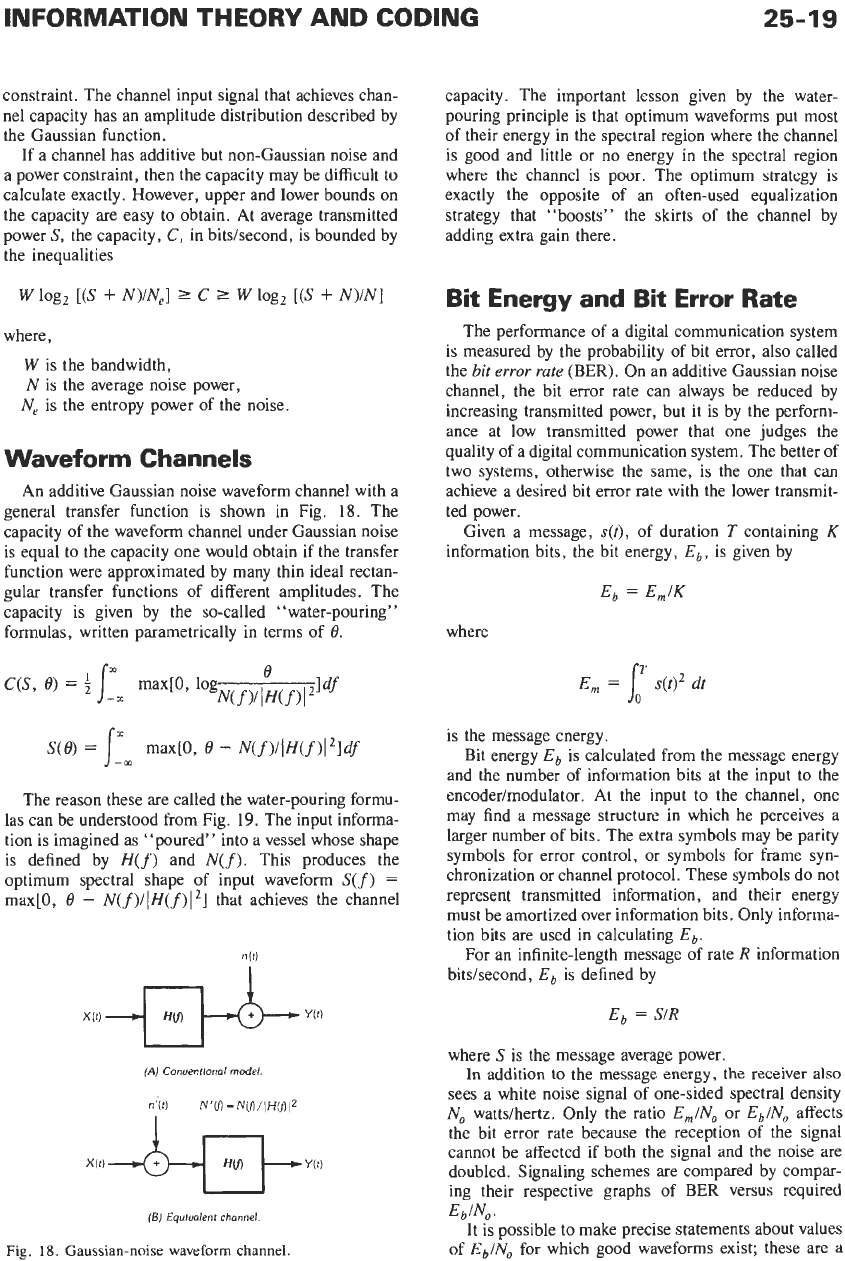
INFORMATION THEORY AND CODING
25-19
constraint. The channel input signal that achieves chan-
nel capacity has an amplitude distribution described by
the Gaussian function.
If a channel has additive but non-Gaussian noise and
a power constraint, then the capacity may be difficult to
calculate exactly. However, upper and lower bounds on
the capacity are easy to obtain. At average transmitted
power
S,
the capacity,
C,
in bitslsecond, is bounded by
the inequalities
W
log2
[(S
+
N)/N,]
2
C
2
W
log2
[(S
+
N)/N]
where,
W
is the bandwidth,
N
is the average noise power,
Ne
is the entropy power of the noise.
Waveform Channels
An additive Gaussian noise waveform channel with a
general transfer function is shown in Fig. 18. The
capacity of the waveform channel under Gaussian noise
is equal to the capacity one would obtain if the transfer
function were approximated by many thin ideal rectan-
gular transfer functions of different amplitudes. The
capacity
is
given by the so-called “water-pouring”
formulas, written parametrically in terms of
0.
The reason these are called the water-pouring formu-
las can be understood from Fig.
19.
The input informa-
tion is imagined as “poured” into a vessel whose shape
is defined by
H(f)
and
N(f).
This produces the
optimum spectral shape of input waveform
S(f)
=
max[0,
0
-
N(f)l/H(f)I2]
that achieves the channel
nit1
(A)
Conuentronal
model
n;it)
N’W
=NU)/~H(~I*
Xit)
-&TFYit)
(13)
Equlvalent
channel
Fig.
18.
Gaussian-noise waveform channel.
capacity. The important lesson given by the water-
pouring principle is that optimum waveforms put most
of their energy in the spectral region where the channel
is good and little or no energy in the spectral region
where the channel
is
poor. The optimum strategy is
exactly the opposite of an often-used equalization
strategy that “boosts” the skirts of the channel by
adding extra gain there.
Bit
Energy
and
Bit
Error
Rate
The performance of a digital communication system
is measured by the probability of bit error, also called
the
bit
error rate
(BER). On an additive Gaussian noise
channel, the bit error rate can always be reduced by
increasing transmitted power, but it is by the perform-
ance at low transmitted power that one judges the
quality of a digital communication system. The better of
two systems, otherwise the same, is the one that can
achieve a desired bit error rate with the lower transmit-
ted power.
Given a message,
s(t),
of duration
T
containing
K
information bits, the bit energy,
E,,
is given by
where
E,
=
1
s(t)’
dt
is the message energy.
Bit energy
E,
is calculated from the message energy
and the number of information bits at the input to the
encoderlmodulator. At the input
to
the channel, one
may find a message structure in which he perceives a
larger number of bits. The extra symbols may be parity
symbols for error control, or symbols for frame syn-
chronization or channel protocol. These symbols do not
represent transmitted information, and their energy
must be amortized over information bits. Only informa-
tion bits are used in calculating
E,.
For an infinite-length message of rate
R
information
bitslsecond,
Eb
is defined by
E,
=
SIR
where
S
is the message average power.
In
addition to the message energy, the receiver also
sees a white noise signal of one-sided spectral density
No
wattslhertz. Only the ratio
E,INo
or
Eb/No
affects
the bit error rate because the reception of the signal
cannot be affected if both the signal and the noise are
doubled. Signaling schemes are compared by compar-
ing their respective graphs of BER versus required
It
is possible to make precise statements about values
of
EbINo
for which good waveforms exist; these are a
EbIN,.
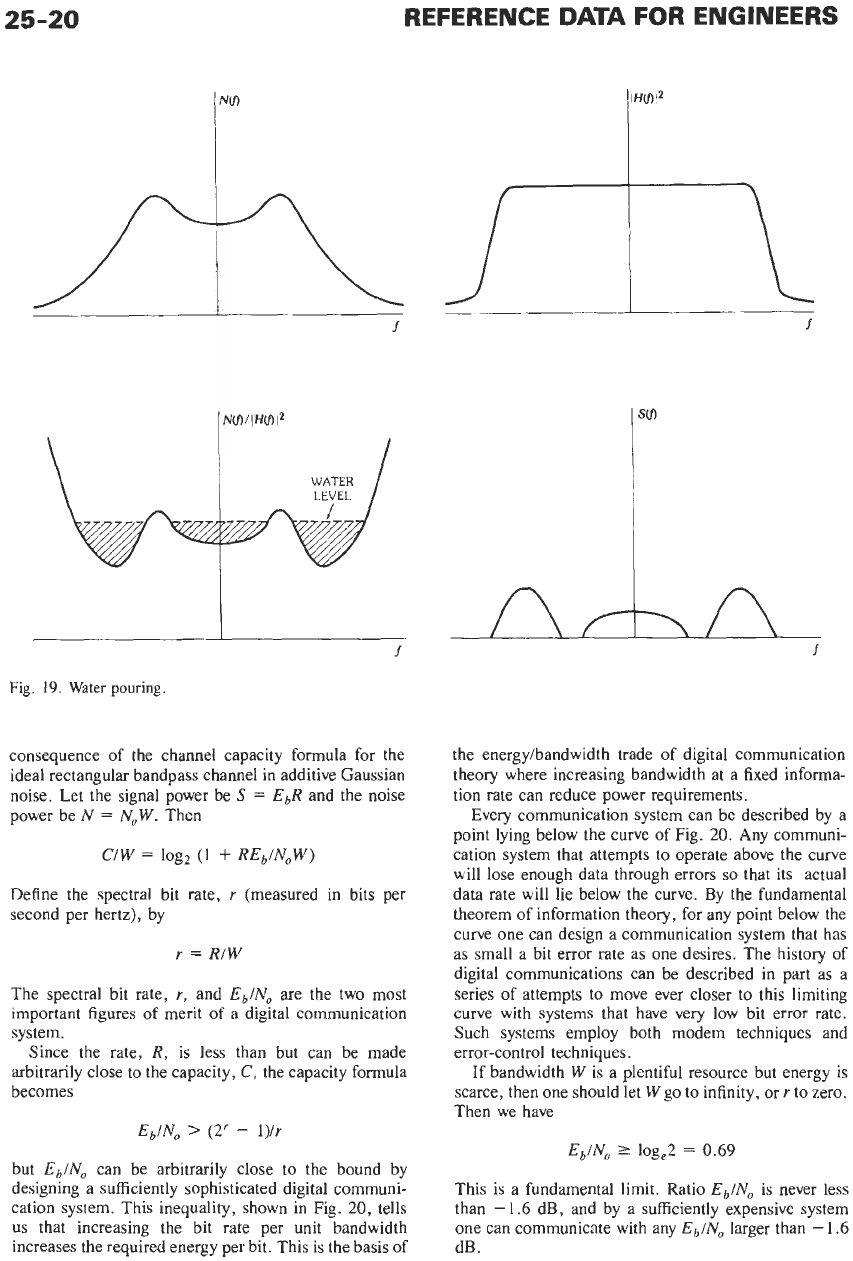
25-20
REFERENCE
DATA
FOR ENGINEERS
f
Fig.
19.
Water
pouring.
consequence of the channel capacity formula for the
ideal rectangular bandpass channel in additive Gaussian
noise. Let the signal power be
S
=
EbR
and the noise
power be
N
=
NOW.
Then
CIW
=
log2
(1
+
REblNoW)
Define the spectral bit rate,
r
(measured in bits per
second per hertz), by
r
=
RIW
The spectral bit rate,
r,
and
Eb/No
are the two most
important figures
of
merit
of
a
digital communication
sys tem
.
Since the rate,
R,
is
less than but can be made
arbitrarily close to the capacity,
C,
the capacity formula
becomes
Eb/No
>
(2’
-
1)/r
but
Eb/No
can be arbitrarily close to the bound by
designing a sufficiently sophisticated digital communi-
cation system. This inequality, shown in Fig. 20, tells
us
that increasing the bit rate per unit bandwidth
increases the required energy per bit. This is the basis of
I
the energylbandwidth trade of digital communication
theory where increasing bandwidth at a fixed informa-
tion rate can reduce power requirements.
Every communication system can be described by a
point lying below the curve of Fig. 20. Any communi-
cation system that attempts to operate above the curve
will lose enough data through errors
so
that its actual
data rate will lie below the curve. By the fundamental
theorem of information theory, for any point below the
curve one can design a communication system that has
as
small a bit error rate as one desires. The history of
digital communications can be described in part as a
series
of
attempts to move ever closer to this limiting
curve with systems that have very low bit error rate.
Such systems employ both modem techniques and
error-control techniques.
If bandwidth
W
is a plentiful resource but energy is
scarce, then one should let
W
go to infinity,
or
r
to zero.
Then we have
EbIN,
2
10g,2
=
0.69
This is a fundamental limit. Ratio
Eb/N,
is never less
than
-
1.6
dB, and by a sufficiently expensive system
one can communicate with any
Eb/No
larger than
-
1.6
dB
.
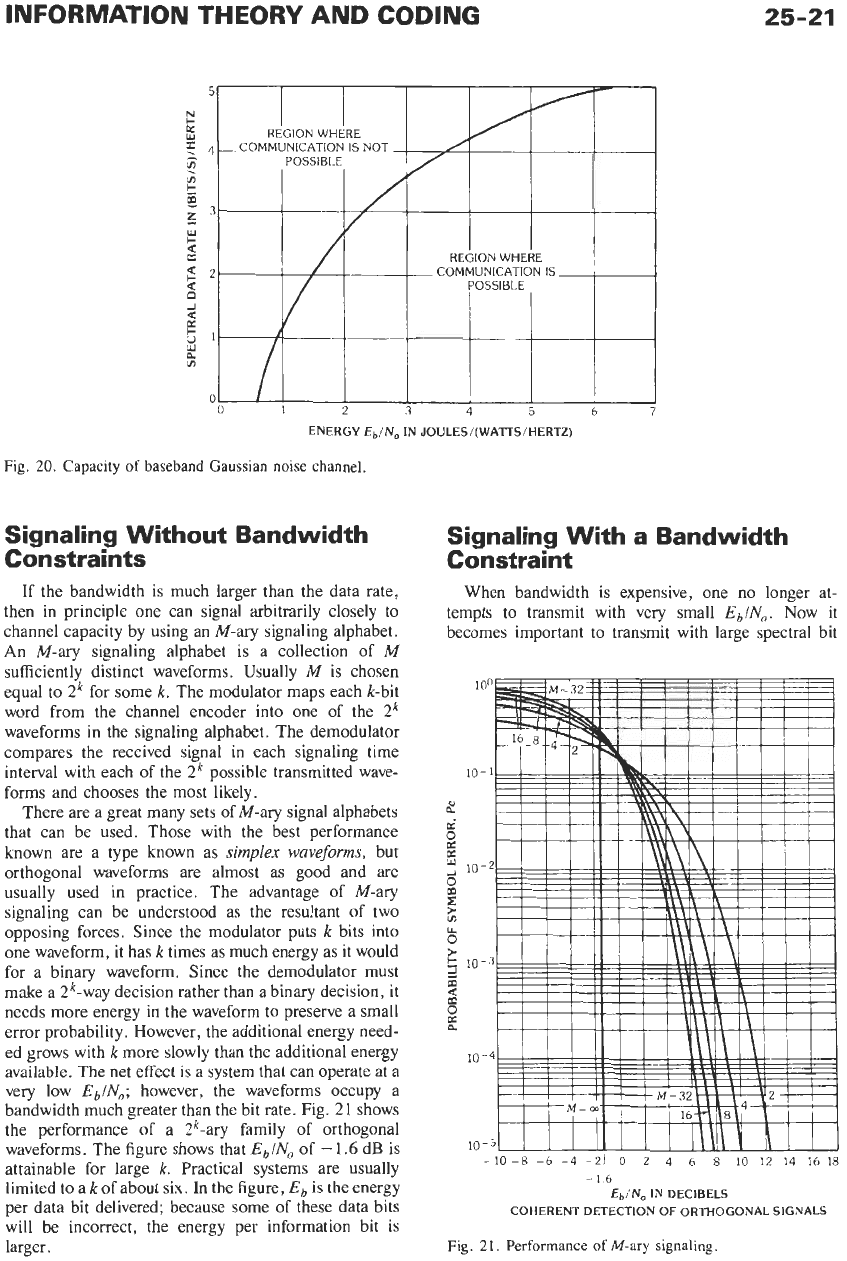
INFORMATION THEORY AND CODING
25-21
ENERGY
EhIN,
IN JOULES/(WATTS/HERTZ)
Fig.
20.
Capacity
of
baseband
Gaussian
noise channel.
Signaling Without Bandwidth
Constraints
If the bandwidth is much larger than the data rate,
then in principle one can signal arbitrarily closely to
channel capacity by using an
M-ary
signaling alphabet.
An
M-ary
signaling alphabet
is
a collection of
M
sufficiently distinct waveforms. Usually
M
is chosen
equal to 2k for some
k.
The modulator maps each k-bit
word from the channel encoder into one of the
2k
waveforms in the signaling alphabet. The demodulator
compares the received signal in each signaling time
interval with each of the 2k possible transmitted wave-
forms and chooses the most likely.
There are a great many sets of M-ary signal alphabets
that can be used. Those with the best performance
known are a type known as
simplex
waveforms,
but
orthogonal waveforms are almost as good and are
usually used in practice. The advantage of M-ary
signaling can be understood as the resultant of two
opposing forces. Since the modulator puts
k
bits into
one waveform, it has
k
times as much energy as it would
for a binary waveform. Since the demodulator must
make a 2k-way decision rather than a binary decision, it
needs more energy in the waveform to preserve a small
error probability. However, the additional energy need-
ed grows with
k
more slowly than the additional energy
available. The net effect
is
a
system that can operate at a
very low
EbINo;
however, the waveforms occupy a
bandwidth much greater than the bit rate. Fig. 21 shows
the performance of a 2k-ary family of orthogonal
waveforms. The figure shows that
Eb/No
of
-
1.6
dB is
attainable for large
k.
Practical systems are usually
limited to a
k
of
about six. In the figure,
E,
is
the energy
per data bit delivered; because some of these data bits
will be incorrect, the energy per information bit
is
larger.
Signaling With a Bandwidth
Constraint
When bandwidth is expensive, one no longer at-
tempts to transmit with very small
Eb/N,.
Now it
becomes important to transmit with large spectral bit
Fig.
21.
Performance
of
M-ary signaling.
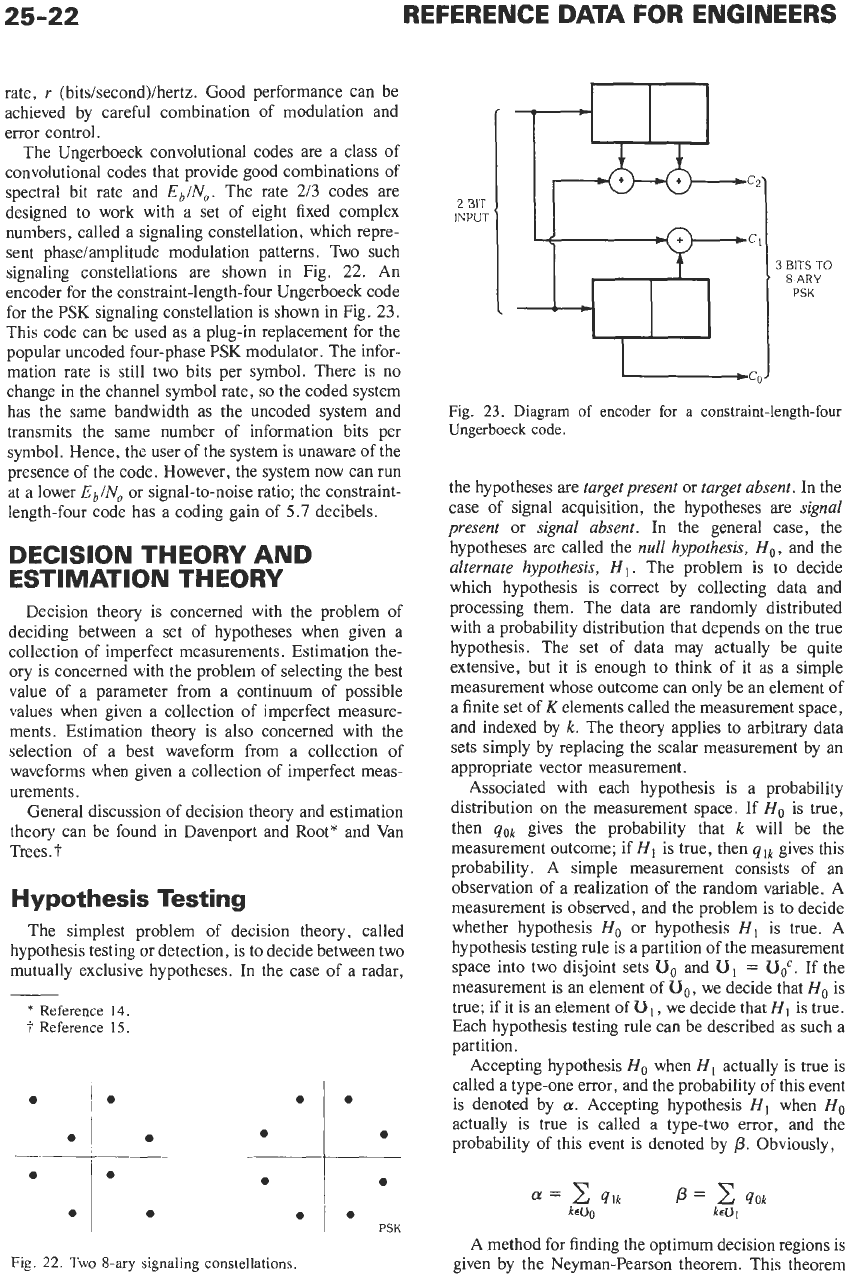
25-22
REFERENCE DATA FOR ENGINEERS
0
0
rate,
r
(bits/second)/hertz. Good performance can be
achieved by careful combination of modulation and
error control.
The Ungerboeck convolutional codes are a class of
convolutional codes that provide good combinations of
spectral bit rate and
Eb/No.
The rate
2/3
codes are
designed to work with a set of eight fixed complex
numbers, called a signaling constellation, which repre-
sent phaseiamplitude modulation patterns. Two such
signaling constellations are shown in Fig.
22.
An
encoder for the constraint-length-four Ungerboeck code
for the PSK signaling constellation is shown in Fig.
23.
This code can be used as a plug-in replacement for the
popular uncoded four-phase PSK modulator. The infor-
mation rate is still two bits per symbol. There is no
change in the channel symbol rate,
so
the coded system
has the same bandwidth as the uncoded system and
transmits the same number
of
information bits per
symbol. Hence, the user of the system is unaware of the
presence of the code. However, the system now can run
at a lower
Eb/No
or signal-to-noise ratio; the constraint-
length-four code has a coding gain of
5.7
decibels.
0
0
0
DECISION THEORY AND
ESTIMATION THEORY
Decision theory is concerned with the problem of
deciding between a set of hypotheses when given a
collection of imperfect measurements. Estimation the-
ory is concerned with the problem
of
selecting the best
value of a parameter from a continuum of possible
values when given a collection of imperfect measure-
ments. Estimation theory is also concerned with the
selection of a best waveform from a collection of
waveforms when given a collection of imperfect meas-
urements.
General discussion of decision theory and estimation
theory can be found in Davenport and Root* and Van
Trees.
7'
Hypothesis Testing
The simplest problem
of
decision theory, called
hypothesis testing or detection, is to decide between two
mutually exclusive hypotheses. In the case
of
a radar.
*
Reference
14.
i
Reference
15.
Fig.
22.
Two
8-ary
signaling constellations.
0
0
0
0
PSK
2
31T
INPUT
3
BITS
TO
8~ARY
PSK
Fig.
23.
Diagram of encoder for
a
constraint-length-four
Ungerboeck code.
the hypotheses are
target present
or
target absent.
In the
case of signal acquisition, the hypotheses are
signal
present
or
signal absent.
In the general case, the
hypotheses are called the
null hypothesis,
H,,
and the
alternate hypothesis,
HI.
The problem
is
to
decide
which hypothesis is correct by collecting data and
processing them. The data are randomly distributed
with a probability distribution that depends on the true
hypothesis. The set of data may actually be quite
extensive, but it is enough to think
of
it as a simple
measurement whose outcome can only be an element of
a finite set
of
K
elements called the measurement space,
and indexed by
k.
The theory applies to arbitrary data
sets simply by replacing the scalar measurement by an
appropriate vector measurement.
Associated with each hypothesis is a probability
distribution on the measurement space. If
Ho
is true,
then
qOk
gives the probability that
k
will be the
measurement outcome; if
HI
is true, then
qlk
gives this
probability. A simple measurement consists of an
observation of a realization of the random variable. A
measurement is observed, and the problem is to decide
whether hypothesis
H,
or hypothesis
HI
is true.
A
hypothesis testing rule is a partition of the measurement
space into two disjoint sets
Uo
and
Ul
=
Uo'.
If the
measurement is an element
of
Uo,
we decide that
Ho
is
true;
if
it
is
an element
of
U
I,
we decide that
HI
is true.
Each hypothesis testing rule can be described as such a
partition.
Accepting hypothesis
H,
when
HI
actually is true is
called a type-one error, and the probability
of
this event
is denoted by
a.
Accepting hypothesis
HI
when
Ho
actually
is
true
is
called a type-two error, and the
probability
of
this event
is
denoted by
p.
Obviously,
=
c.
qlk
p
=
qOk
k€U,
keU
I
A method for finding the optimum decision regions
is
given by the Neyman-Pearson theorem. This theorem
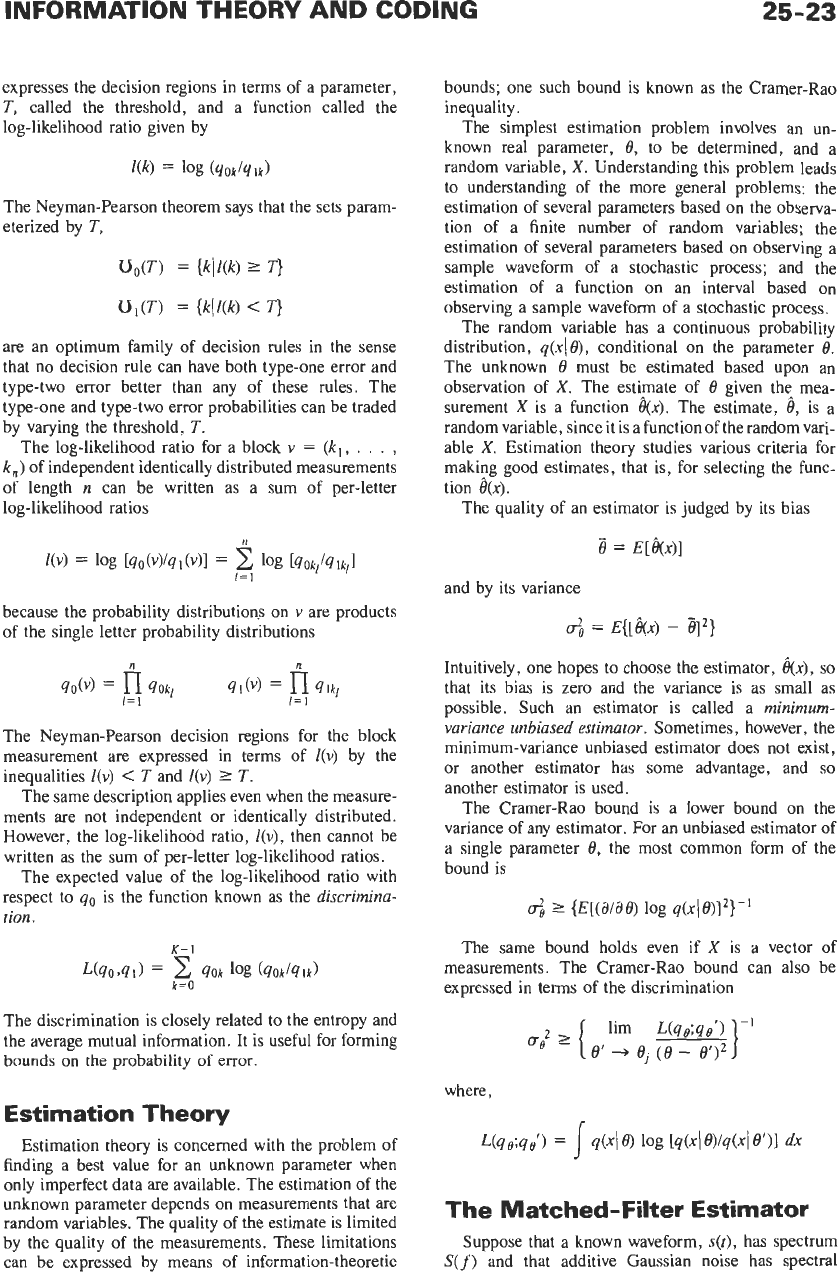
INFORMATION
THEORY
AND CODING
25-23
expresses the decision regions in terms of a parameter,
T,
called the threshold, and a function called the
log-likelihood ratio given by
[(k)
=
1%
(qOklqlk)
The Neyman-Pearson theorem says that the sets param-
eterized by
T,
Uo(T)
=
{kll(k)
2
T}
Ui(T)
=
{k(Z(k)
<
TI
are an optimum family of decision rules in the sense
that no decision rule can have both type-one error and
type-two error better than any
of
these rules. The
type-one and type-two error probabilities can be traded
by varying the threshold,
T.
The log-likelihood ratio for a block
v
=
(kl,
.
.
.
,
k,)
of independent identically distributed measurements
of
length
n
can be written as a sum of per-letter
log-likelihood ratios
because the probability distributions on
v
are products
of the single letter probability distributions
The Neyman-Pearson decision regions for the block
measurement are expressed in terms
of
Z(v)
by the
inequalities
l(v)
<
T
and
Z(v)
2
T.
The same description applies even when the measure-
ments are not independent or identically distributed.
However, the log-likelihood ratio,
I(v),
then cannot be
written as the sum of per-letter log-likelihood ratios.
The expected value of the log-likelihood ratio with
respect
to
qo
is the function known as the
discrimina-
tion.
K-
1
L(q0,ql)
=
2
qOk
log
(qOklqlk)
k=O
The discrimination is closely related to the entropy and
the average mutual information. It is useful for forming
bounds
on
the
probability
of
error.
Estimation Theory
Estimation theory is concerned with the problem of
finding a best value for an unknown parameter when
only imperfect data are available. The estimation
of
the
unknown parameter depends on measurements that are
random variables. The quality of the estimate is limited
by the quality of the measurements. These limitations
can be expressed by means of information-theoretic
bounds; one such bound is known as the Cramer-Rao
inequality.
The simplest estimation problem involves an un-
known real parameter,
0,
to be determined,
and a
random variable,
X.
Understanding this problem leads
to understanding of the more general problems: the
estimation of several parameters based on the observa-
tion
of
a finite number of random variables; the
estimation of several parameters based on observing a
sample waveform of a stochastic process; and the
estimation of a function on an interval based on
observing a sample waveform of a stochastic process.
The random variable has a continuous probability
distribution,
q(x(
e),
conditional on the parameter
8.
The unknown
0
must be estimated based upon an
observation of
X.
The esti-mate of
8
given then mea-
surement
X
is a function
@).
The estimate,
8,
is a
random variable, since it is a function of the random vari-
able
x.
Estimation theory studies various criteria for
maki?g good estimates, that is, for selecting the func-
tion
8(x).
The quality of an estimator
is
judged by its bias
8
=
E[&x)]
and by its variance
Intuitively, one hopes to choose the estimator,
&x),
so
that its bias
is zero and the variance is as small as
possible. Such an estimator is called a
minimum-
variance unbiased estimator.
Sometimes, however, the
minimum-variance unbiased estimator does not exist,
or another estimator has some advantage, and
so
another estimator is used.
The Cramer-Rao bound is a lower bound on the
variance
of
any estimator. For an unbiased estimator of
a single parameter
0,
the most common form of the
bound is
The same bound holds even if
X
is a vector of
measurements. The Cramer-Rao bound can also be
expressed in terms of the discrimination
where,
The Matched-Filter Estimator
Suppose that a known waveform,
s(t),
has spectrum
S(f)
and that additive Gaussian noise has spectral
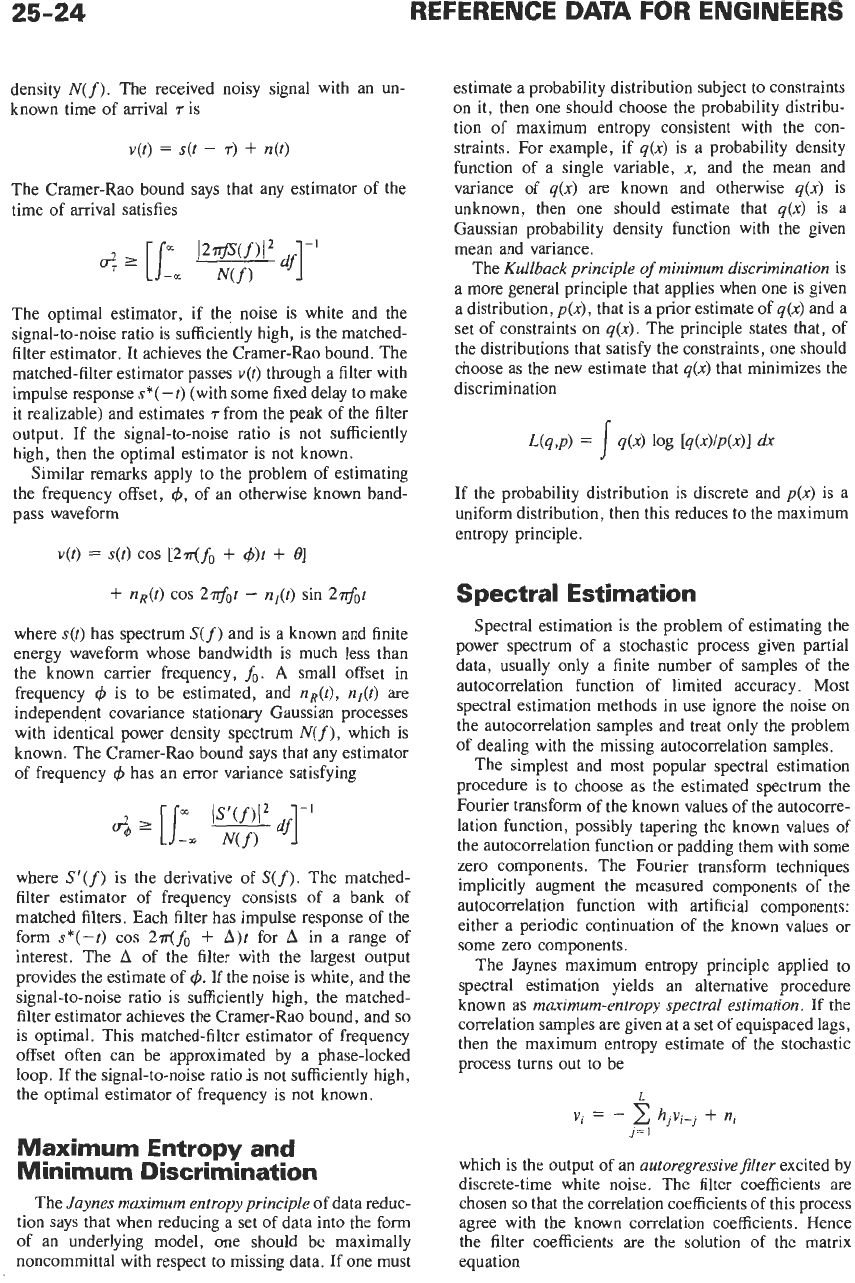
density
N(f).
The received noisy signal with an un-
known time of arrival
7
is
v(t)
=
s(t
-
T)
+
n(t)
The Cramer-Rao bound says that any estimator of the
time of arrival satisfies
The optimal estimator, if the noise is white and the
signal-to-noise ratio is sufficiently high, is the matched-
filter estimator. It achieves the Cramer-Rao bound. The
matched-filter estimator passes
v(t)
through a filter with
impulse response
s*(-t)
(with some fixed delay to make
it realizable) and estimates
T
from the peak of the filter
output. If the signal-to-noise ratio is not sufficiently
high, then the optimal estimator is not known.
Similar remarks apply to the problem of estimating
the frequency offset,
4,
of an otherwise known band-
pass waveform
v(t)
=
s(t)
cos
[27T(fo
+
4)t
+
e1
+
nR(t)
cos
27rj0t
-
n,(t)
sin
27rjot
where
s(t)
has spectrum
S(
f)
and is a known and finite
energy waveform whose bandwidth is much less than
the known carrier frequency,
fo.
A
small offset in
frequency
4
is to be estimated, and
nR(t),
nI(t)
are
independent covariance stationary Gaussian processes
with identical power density spectrum
N(f),
which is
known. The Cramer-Rao bound says that any estimator
of frequency
4
has an error variance satisfying
where
S‘(
f)
is the derivative of
S(f).
The matched-
filter estimator of frequency consists of a bank of
matched filters. Each filter has impulse response of the
form
s*(-t)
cos
2n(fo
+
A)t
for
A
in a range of
interest. The
A
of the filter with the largest output
provides the estimate of
4.
If the noise
is
white, and the
signal-to-noise ratio is sufficiently high, the matched-
filter estimator achieves the Cramer-Rao bound, and
so
is
optimal. This matched-filter estimator of frequency
offset often can be approximated by a phase-locked
loop. If the signal-to-noise ratio
is
not sufficiently high,
the optimal estimator of frequency is not known.
Maximum Entropy and
Minimum Discrimination
The
Jaynes maximum entropy principle
of data reduc-
tion says that when reducing a set of data into the form
of an underlying model, one should be maximally
noncommittal with respect to missing data. If one must
estimate a probability distribution subject to constraints
on it, then one should choose the probability distribu-
tion of maximum entropy consistent with the con-
straints. For example, if
q(x)
is a probability density
function of a single variable,
x,
and the mean and
variance of
q(x)
are known and otherwise
q(x)
is
unknown, then one should estimate that
q(x) is
a
Gaussian probability density function with the given
mean and variance.
The
Kullback principle
of
minimum discrimination
is
a more general principle that applies when one is given
a distribution,
p(x),
that is a prior estimate of
q(x)
and a
set of constraints on
q(x).
The principle states that, of
the distributions that satisfy the constraints, one should
choose
as
the new estimate that
q(x)
that minimizes the
discrimination
If the probability distribution is discrete and
p(x)
is a
uniform distribution, then this reduces to the maximum
entropy principle.
Spectral Estimation
Spectral estimation is the problem of estimating the
power spectrum of a stochastic process given partial
data, usually only a finite number of samples
of
the
autocorrelation function of limited accuracy. Most
spectral estimation methods in use ignore the noise on
the autocorrelation samples and treat only the problem
of dealing with the missing autocorrelation samples.
The simplest and most popular spectral estimation
procedure is to choose as the estimated spectrum the
Fourier transform of the known values of the autocorre-
lation function, possibly tapering the known values of
the autocorrelation function or padding them with some
zero components. The Fourier transform techniques
implicitly augment the measured components of the
autocorrelation function with artificial components:
either a periodic continuation of the known values or
some zero components.
The Jaynes maximum entropy principle applied to
spectral estimation yields
an
alternative procedure
known as
maximum-entropy spectral estimation.
If
the
correlation samples are given at a set of equispaced lags,
then the maximum entropy estimate of the stochastic
process turns out to be
which is the output of an
autoregressiveJi1ter
excited
by
discrete-time white noise. The filter coefficients are
chosen
so
that the correlation coefficients of this process
agree with the known correlation coefficients. Hence
the filter coefficients are the solution of the matrix
equation
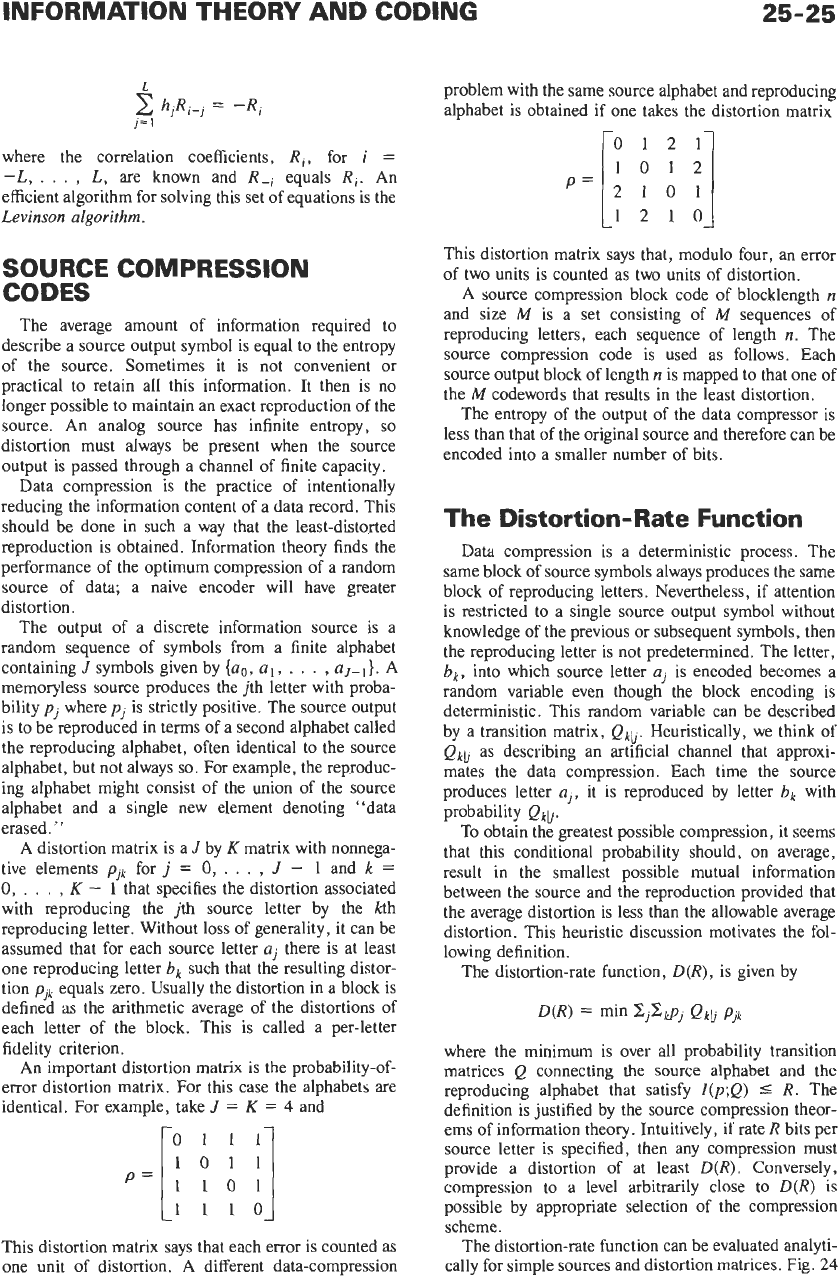
5
hiRi-j
=
-Ri
j=
1
where the correlation coefficients,
Ri,
for
i
=
-L,
. . .
,
L,
are known and
R+
equals
R,.
An
efficient algorithm for solving this set of equations is the
Levinson
algorithm.
SOURCE COMPRESSION
The average amount of information required to
describe a source output symbol is equal to the entropy
of the source. Sometimes it is not convenient or
practical to retain all this information. It then is no
longer possible
to
maintain an exact reproduction
of
the
source. An analog source has infinite entropy,
so
distortion must always be present when the source
output is passed through a channel of finite capacity.
Data compression is the practice of intentionally
reducing the information content of a data record. This
should be done in such a way that the least-distorted
reproduction is obtained. Information theory finds the
performance of the optimum compression of a random
source of data; a naive encoder will have greater
distortion.
The output of a discrete information source is a
random sequence of symbols from a finite alphabet
containing
J
symbols given by
{ao,
al,
.
.
.
,
aJ-,}.
A
memoryless source produces the jth letter with proba-
bility
pj
where
pj
is strictly positive. The source output
is
to be reproduced in terms of a second alphabet called
the reproducing alphabet, often identical to the source
alphabet, but not always
so.
For example, the reproduc-
ing alphabet might consist of the union of the source
alphabet and a single new element denoting “data
erased.”
A distortion matrix is a
J
by
K
matrix with nonnega-
tive elements
pjk
for
j
=
0,
.
.
.
,
J
-
1
and
k
=
0,
.
.
.
,
K
-
1
that specifies the distortion associated
with reproducing the
jth
source letter by the kth
reproducing letter. Without loss
of
generality, it can be
assumed that for each source letter
aj
there is at least
one reproducing letter
bk
such that the resulting distor-
tion
pjk
equals zero. Usually the distortion in a block is
defined as the arithmetic average
of
the distortions of
each letter of the block. This
is
called a per-letter
fidelity criterion.
An
important distortion matrix is the probability-of-
error distortion matrix. For this case the alphabets are
identical. For example, take
J
=
K
=
4
and
[;
j
11
p=llol
This distortion matrix says that each error is counted as
one unit
of
distortion.
A
different data-compression
problem with the same source alphabet and reproducing
alphabet is obtained if one takes the distortion matrix
This distortion matrix says that, modulo four, an error
of two units is counted as two units of distortion.
A source compression block code of blocklength
n
and size
M
is a set consisting of
M
sequences of
reproducing letters, each sequence of length
n.
The
source compression code is used as follows. Each
source output block of length
n
is mapped to that one of
the
M
codewords that results in the least distortion.
The entropy of the output of the data compressor is
less than that of the original source and therefore can be
encoded into a smaller number of bits.
The
Distortion-Rate Function
Data compression is a deterministic process. The
same block of source symbols always produces the same
block
of
reproducing letters. Nevertheless, if attention
is restricted to a single source output symbol without
knowledge of the previous or subsequent symbols, then
the reproducing letter is not predetermined. The letter,
bk,
into which source letter
uj
is encoded becomes a
random variable even though the block encoding is
deterministic. This random variable can be described
by a transition matrix,
Qkb.
Heuristically, we think of
Qkb
as describing an artificial channel that approxi-
mates the data compression. Each time the source
produces letter
a),
it is reproduced by letter
bk
with
probability
Qkb.
To obtain the greatest possible compression, it seems
that this conditional probability should, on average,
result in the smallest possible mutual information
between the source and the reproduction provided that
the average distortion is
less
than the allowable average
distortion. This heuristic discussion motivates the fol-
lowing definition.
The distortion-rate function,
D(R),
is given by
where the minimum is over all probability transition
matrices
Q
connecting the source alphabet and the
reproducing alphabet that satisfy
I(p;Q)
5
R.
The
definition is justified by the source compression theor-
ems of information theory. Intuitively, if rate R bits per
source letter is specified, then any compression must
provide a distortion of at least
D(R).
Conversely,
compression to a level arbitrarily close to
D(R)
is
possible by appropriate selection of the compression
scheme.
The distortion-rate function can be evaluated analyti-
cally for simple sources and distortion matrices. Fig.
24
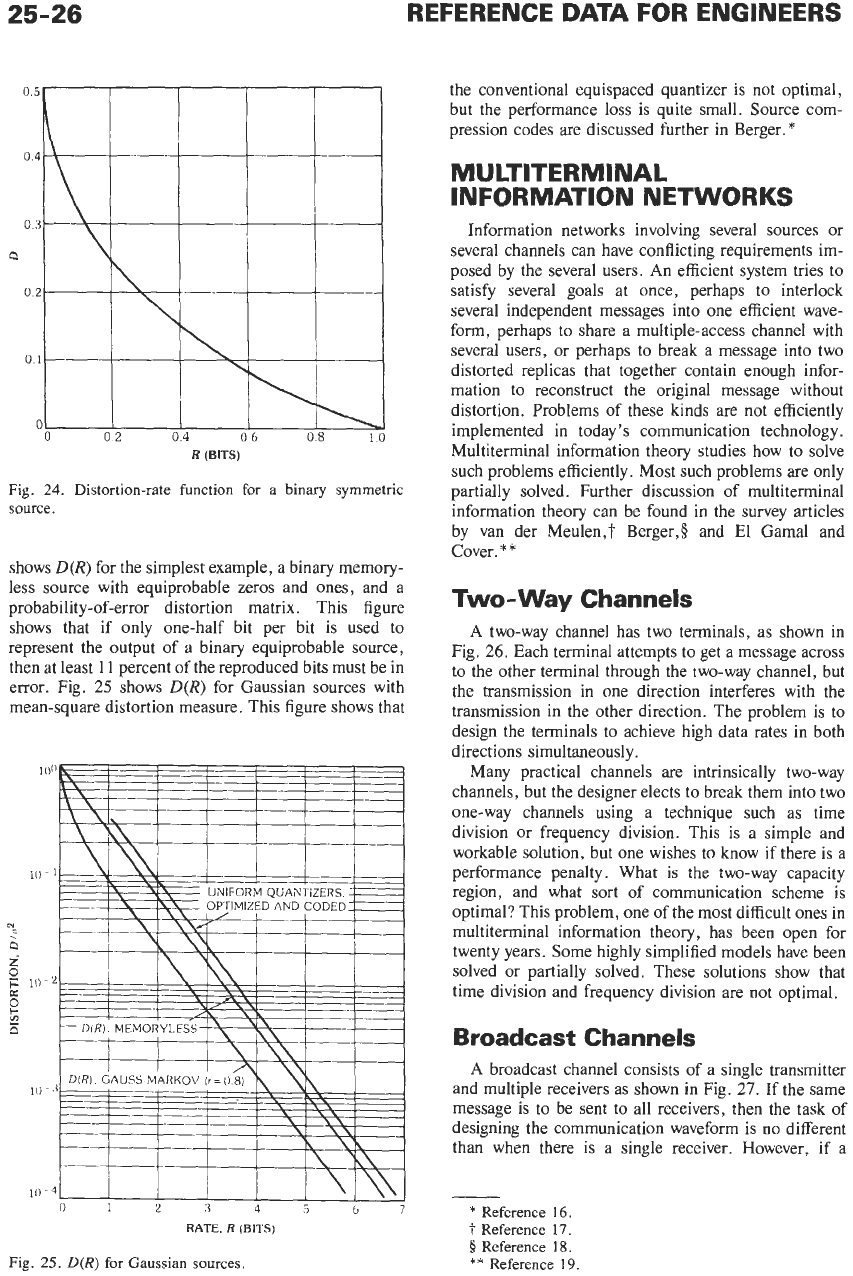
25-26
REFERENCE
DATA
FOR ENGINEERS
R
(BITS)
Fig.
24.
Distortion-rate function
for
a
binary symmetric
source.
shows
D(R)
for the simplest example, a binary memory-
less source with equiprobable zeros and ones, and a
probability-of-error distortion matrix. This figure
shows that if only one-half bit per bit is used to
represent the output of a binary equiprobable source,
then at least 11 percent of the reproduced bits must be in
error. Fig.
25
shows
D(R)
for Gaussian sources with
mean-square distortion measure. This figure shows that
IO
N
5
2
0
c
10
E
2
10
10
1
t
I
Y
\Y
I
I
-3
0
12
3
4
5
6
7
RATE.
R
(BITS)
Fig.
25.
D(R)
for
Gaussian
sources.
the conventional equispaced quantizer
is
not optimal,
but the performance loss is quite small. Source com-
pression codes are discussed further in Berger.
*
MULTITERMINAL
INFORMATION
NETWORKS
Information networks involving several sources or
several channels can have conflicting requirements im-
posed by the several users.
An
efficient system tries to
satisfy several goals at once, perhaps to interlock
several independent messages into one efficient wave-
form, perhaps to share a multiple-access channel with
several users, or perhaps to break
a
message into two
distorted replicas that together contain enough infor-
mation to reconstruct the original message without
distortion. Problems of these kinds are not efficiently
implemented in today’s communication technology.
Multiterminal information theory studies how to solve
such problems efficiently. Most such problems are only
partially solved. Further discussion of multiterminal
information theory can be found in the survey articles
by van der Meulen,? Berger,# and El Gama1 and
Cover.
*
*
Two-way
Channels
A
two-way channel has two terminals, as shown in
Fig.
26.
Each terminal attempts to get a message across
to the other terminal through the two-way channel, but
the transmission in one direction interferes with the
transmission in the other direction. The problem is
to
design the terminals
to
achieve high data rates in both
directions simultaneously.
Many practical channels are intrinsically two-way
channels, but the designer elects to break them into two
one-way channels using a technique such as time
division or frequency division. This is a simple and
workable solution, but one wishes to know if there
is
a
performance penalty. What is the two-way capacity
region, and what sort of communication scheme is
optimal? This problem, one of the most difficult ones
in
multiterminal information theory, has been open for
twenty years. Some highly simplified models have been
solved or partially solved. These solutions show that
time division and frequency division are not optimal.
Broadcast Channels
A
broadcast channel consists
of
a single transmitter
and multiple receivers as shown in Fig.
27.
If the same
message is to be sent to all receivers, then the task of
designing the communication waveform is
no
different
than when there is a single receiver. However, if a
*
Reference
16.
1-
Reference 17.
8
Reference 18.
**
Reference
19.
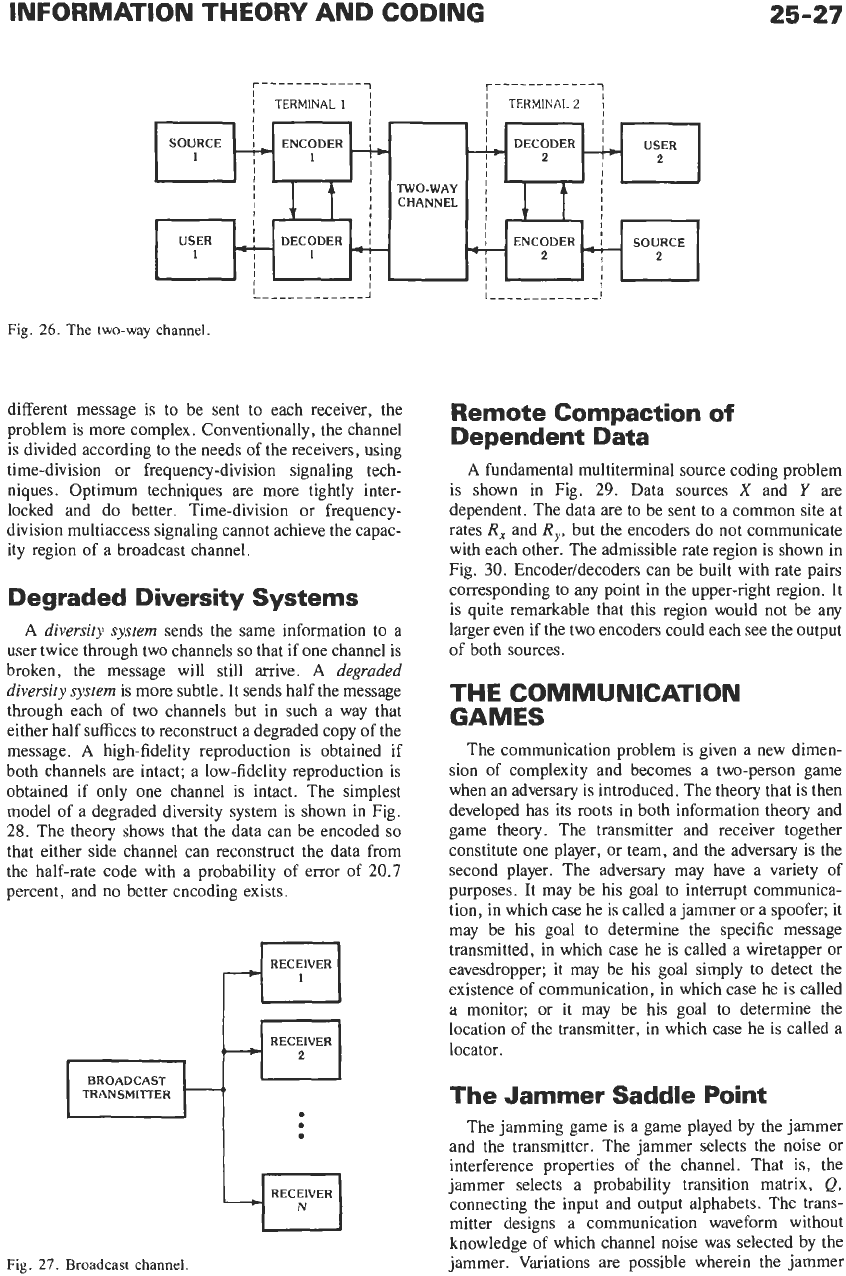
INFORMATION THEORY AND CODING
I
SOURCE
I
ENCODER
I
1
1
I
I
25-27
I
I
I
&
I I
I
I
I
r------------1
r------------,
I
I
TERMINAL
1
I
I
TERMINAL2
\
I
I
I
I
1-
I
I
1
I
1
I
I
USER
-
DECODER
I
I
I
I
I
CHANNEL
I
I I
tj-
I
ENCODER
I
SOURCE
I
I
I
I
‘r2
-2
different message is to be sent to each receiver, the
problem is more complex. Conventionally, the channel
is divided according to the needs of the receivers, using
time-division or frequency-division signaling tech-
niques. Optimum techniques are more tightly inter-
locked and do better.
Time-division or frequency-
division multiaccess signaling cannot achieve the capac-
ity region of a broadcast channel.
BROADCAST
TRANSMITTER
Degraded Diversity Systems
-’
.
A
diversity system
sends the same information to a
user twice through two channels
so
that if one channel is
broken, the message will still arrive.
A
degraded
diversity system
is more subtle. It sends half the message
through each of two channels but in such a way that
either half suffices to reconstruct a degraded copy of the
message.
A
high-fidelity reproduction is obtained if
both channels are intact; a low-fidelity reproduction is
obtained if only one channel is intact. The simplest
model of a degraded diversity system is shown in Fig.
28.
The theory shows that the data can be encoded
so
that either side channel can reconstruct the data from
the half-rate code with a probability of error of
20.7
percent, and no better encoding exists.
.
.
RECEIVER
n
-N
RECEIVER
w
Fig.
27.
Broadcast
channel.
Remote Compaction
of
Dependent Data
A
fundamental multiterminal source coding problem
is shown in Fig.
29.
Data sources
X
and
Y
are
dependent. The data are to be sent to a common site at
rates R, and R,, but the encoders do not communicate
with each other. The admissible rate region is shown in
Fig.
30.
Encoder/decoders can be built with rate pairs
corresponding to any point in the upper-right region.
It
is quite remarkable that this region would not be any
larger even if the two encoders could each see the output
of both sources.
THE
COMMUNICATION
GAMES
The communication problem is given a new dimen-
sion of complexity and becomes a two-person game
when an adversary is introduced. The theory that is then
developed has its roots in both information theory and
game theory. The transmitter and receiver together
constitute one player, or team, and the adversary is the
second player. The adversary may have a variety of
purposes. It may be his goal to interrupt communica-
tion, in which case he is called a jammer or a spoofer; it
may be his goal to determine the specific message
transmitted, in which case he is called a wiretapper or
eavesdropper; it may be his goal simply to detect the
existence of communication, in which case he is called
a monitor; or it may be his goal to determine the
location of the transmitter, in which case he is called a
locator.
The
Jammer Saddle Point
The jamming game is a game played by the jammer
and the transmitter. The jammer selects the noise
or
interference properties of the channel. That is, the
jammer selects a probability transition matrix,
Q,
connecting the input and output alphabets. The trans-
mitter designs a communication waveform without
knowledge of which channel noise was selected by the
jammer. Variations are possible wherein the jammer
